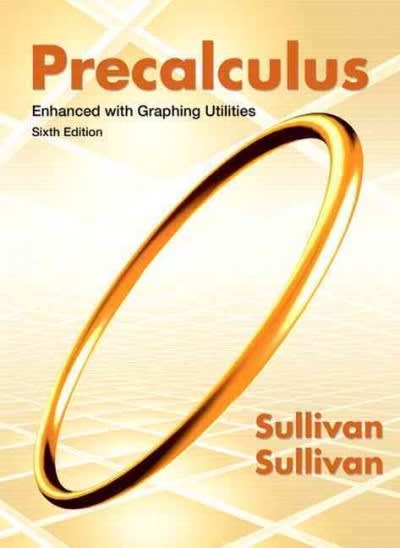Question
Random samples of two species of iris gave the following petal lengths (in cm). x 1 , Iris virginica 5.55.94.54.95.74.85.86.45.75.9 x 2 , Iris versicolor
Random samples of two species of iris gave the following petal lengths (in cm).x1,Iris virginica5.55.94.54.95.74.85.86.45.75.9x2,Iris versicolor4.54.14.75.03.85.14.44.2
(a) Use a 5% level of significance to test the claim that the population standard deviation ofx1
is larger than 0.55.
What is the level of significance?
State the null and alternate hypotheses.
H0:= 0.55;H1:0.55
H0:= 0.55;H1:< 0.55
H0:> 0.55;H1:= 0.55
H0:= 0.55;H1:> 0.55
Find the value of the chi-square statistic for the sample. (Round your answer to two decimal places.)
What are the degrees of freedom?
What assumptions are you making about the original distribution?
We assume a uniform population distribution.
We assume a exponential population distribution.
We assume a normal population distribution.
We assume a binomial population distribution.
Find or estimate theP-value of the sample test statistic.
P-value > 0.100
0.050 <P-value < 0.100
0.025 <P-value < 0.050
0.010 <P-value < 0.025
0.005 <P-value < 0.010
P-value < 0.005
Will you reject or fail to reject the null hypothesis?
Since theP-value >, we fail to reject the null hypothesis.
Since theP-value >, we reject the null hypothesis.
Since theP-value, we reject the null hypothesis.
Since theP-value, we fail to reject the null hypothesis.
Interpret your conclusion in the context of the application.
At the 5% level of significance, there is insufficient evidence to conclude conclude that the standard deviation is greater than 0.55.
At the 5% level of significance, there is sufficient evidence to conclude conclude that the standard deviation is greater than 0.55.
(b) Find a 90% confidence interval for the population standard deviation ofx1.
(Round your answers to two decimal places.)
lower limitupper limit
(c) Use a 1% level of significance to test the claim that the population variance ofx1
is larger than that ofx2.
Interpret the results.
What is the level of significance?
State the null and alternate hypotheses.
H0:12=22;H1:12>22
H0:12>22;H1:12=22
H0:22=12;H1:22>12
H0:12=22;H1:1222
Find the value of the sampleFstatistic. (Round your answer to two decimal places.)
What are the degrees of freedom?dfN=dfD=
What assumptions are you making about the original distribution?
The populations follow dependent normal distributions. We have random samples from each population.
The populations follow independent normal distributions.
The populations follow independent normal distributions. We have random samples from each population.
The populations follow independent chi-square distributions. We have random samples from each population.
Find or estimate theP-value of the sample test statistic.
P-value > 0.100
0.050 <P-value < 0.100
0.025 <P-value < 0.050
0.010 <P-value < 0.025
0.001 <P-value < 0.010
P-value < 0.001
Will you reject or fail to reject the null hypothesis?
At the= 0.01 level, we reject the null hypothesis and conclude the data are not statistically significant.
At the= 0.01 level, we reject the null hypothesis and conclude the data are statistically significant.
At the= 0.01 level, we fail to reject the null hypothesis and conclude the data are not statistically significant.
At the= 0.01 level, we fail to reject the null hypothesis and conclude the data are statistically significant.
Interpret your conclusion in the context of the application.
Fail to reject the null hypothesis, there is sufficient evidence that the variance in iris petal length is greater in the first plot.
Reject the null hypothesis, there is insufficient evidence that the variance in iris petal length is greater in the first plot.
Reject the null hypothesis, there is sufficient evidence that the variance in iris petal length is greater in the first plot.
Fail to reject the null hypothesis, there is insufficient evidence that the variance in iris petal length is greater in the first plot.
Step by Step Solution
There are 3 Steps involved in it
Step: 1

Get Instant Access to Expert-Tailored Solutions
See step-by-step solutions with expert insights and AI powered tools for academic success
Step: 2

Step: 3

Ace Your Homework with AI
Get the answers you need in no time with our AI-driven, step-by-step assistance
Get Started


